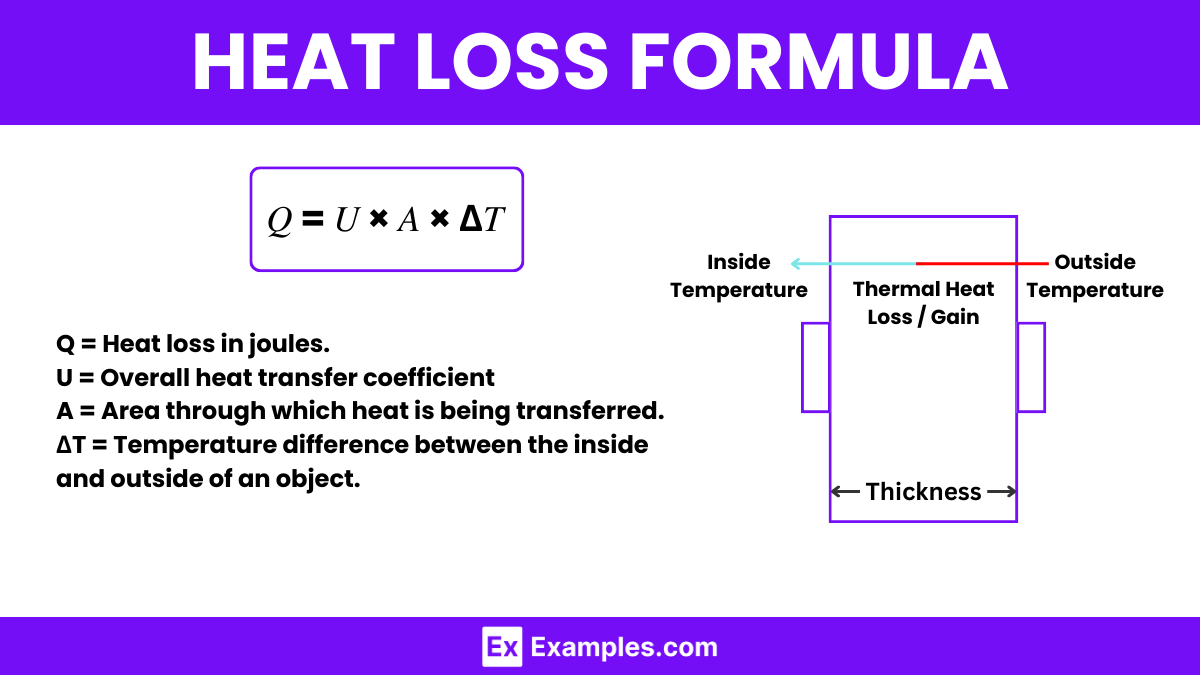What is the general formula for calculating heat loss through a material?
Q = mcΔT
Q = UAΔT
Q = mL
Q = E = hf


The heat loss formula is crucial in physics for calculating the energy transferred from a warmer object to a cooler environment over a specific time. This formula is particularly useful in fields such as thermodynamics and building engineering, where understanding and managing heat transfer is essential. The general formula for heat loss, discovered by the French physicist Joseph Fourier in the 19th century, is expressed as
Fourier’s work laid the foundation for what would later be formalized as Fourier’s Law of Heat Conduction. This principle helps in calculating the rate at which heat escapes through materials, which is vital for designing efficient thermal insulation and for enhancing energy conservation in buildings and industrial applications. The formula not only allows engineers to predict how much heat loss will occur but also to design measures to reduce unnecessary energy expenditures effectively.
Fourier’s Law Expression: The equation based on Fourier’s Law is initially expressed as:
Simplifying Assumptions: For a clearer analysis, it’s assumed that the heat flow is steady-state (constant temperature difference) and one-dimensional. With these assumptions, the equation simplifies to:
Incorporating Heat Transfer Coefficient: In practical scenarios where materials are often layered, incorporating the concept of thermal resistance and the overall heat transfer coefficient, 𝑈, is beneficial. This coefficient is the inverse of the total thermal resistance of the materials’ assembly. Modifying the equation to include this gives:
This form of the equation now details the rate of heat loss through a material characterized by an area 𝐴 and an overall heat transfer coefficient 𝑈 across a temperature difference Δ𝑇.
Total Heat Loss Over Time: To determine the total heat loss for a specific duration, the time variable is typically included. However, if the interest lies in understanding the rate of heat loss per unit time, we retain the rate form
Problem: Calculate the heat loss per hour from a house with walls that have a total area of 150 square meters. The overall heat transfer coefficient (U-value) of the walls is 0.35 W/m²°C. The temperature inside the house is 22°C, and the outside temperature is -3°C.
Solution:
Formula: 𝑄=𝑈×𝐴×Δ𝑇Q=U×A×ΔT
Given:
𝑈 = 0.35 W/m²°C
𝐴 = 150 m²
Δ𝑇 = 22 − (−3) = 25 °C
Calculate:
𝑄 = 0.35 × 150 × 25
𝑄 = 0.35 × 150 × 25 =1312.5 watts
Answer: The house loses 1,312.5 watts of heat per hour.
Problem: Determine the heat loss in watts through a window measuring 1.2 meters by 1.5 meters if the U-value is 1.8 W/m²°C and the temperature difference between the inside and outside is 15°C.
Solution:
Formula: 𝑄 = 𝑈 × 𝐴 × Δ𝑇
Given:
𝑈=1.8 W/m²°C
𝐴 = 1.2 × 1.5 = 1.8 m²
Δ𝑇 = 15 °C
Calculate:
𝑄=1.8×1.8×15
𝑄=1.8×1.8×15=48.6 watts
Answer: The window loses 48.6 watts of heat.
Problem: A hot water pipe has a surface area of 0.75 m² and is exposed to a room where the temperature is consistently 18°C lower than the surface temperature of the pipe. If the U-value of the pipe’s insulation is 0.25 W/m²°C, calculate the heat loss.
Solution:
Formula: 𝑄 = 𝑈 × 𝐴 × Δ𝑇
Given:
𝑈 = 0.25 W/m²°C
𝐴 = 0.75 m²
Δ𝑇 = 18 °C
Calculate:
𝑄 = 0.25 × 0.75 × 18
𝑄 = 0.25 × 0.75 × 18 = 3.375 watts
Answer: The pipe loses 3.375 watts of heat.
The formula for current heat loss is 𝑄=𝐼² × 𝑅 × 𝑡, where 𝐼 is current, R resistance, and t time.
Heat loss by convection is calculated using 𝑄 = ℎ × 𝐴 × Δ𝑇 , where h is the convective heat transfer coefficient.
The basic formula for heat transfer is 𝑄 = 𝑈 × 𝐴 × Δ𝑇, suitable for conduction and convection scenarios.
Text prompt
Add Tone
10 Examples of Public speaking
20 Examples of Gas lighting
What is the general formula for calculating heat loss through a material?
Q = mcΔT
Q = UAΔT
Q = mL
Q = E = hf
In the formula Q = UAΔT, what does 'U' represent?
Specific heat capacity
Thermal conductivity
Overall heat transfer coefficient
Temperature difference
Which of the following units is used for the overall heat transfer coefficient 'U'?
W/m²K
J/kgK
W/mK
J/m²
What is the significance of the area 'A' in the heat loss formula Q = UAΔT?
It affects the mass of the material
It determines the specific heat capacity
It influences the amount of heat loss
It is irrelevant to heat transfer
How does increasing the temperature difference (ΔT) affect the heat loss in the formula Q = UAΔT?
It decreases heat loss
It remains the same
It increases heat loss
It becomes zero
Which factor does not affect the overall heat transfer coefficient 'U'?
Thermal conductivity of the material
Thickness of the material
Specific heat capacity
Type of material
What does the term 'Q' represent in the heat loss formula Q = UAΔT?
Heat transfer coefficient
Heat loss
Temperature difference
Area
If the area (A) is doubled in the formula Q = UAΔT, what happens to the heat loss (Q)?
It remains the same
It is halved
It doubles
It becomes zero
What unit is used to measure heat loss (Q) in the SI system?
Joules (J)
Watts (W)
Kelvin (K)
Meters (m)
In the context of heat loss, what does the term 'thermal conductivity' refer to?
Ability of a material to store heat
Rate at which a material transfers heat
Temperature change over time
Resistance to heat flow
Before you leave, take our quick quiz to enhance your learning!

